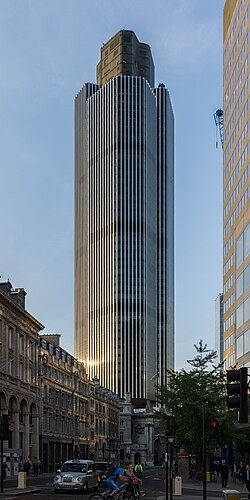Tower 42
| Tower 42 | |
|---|---|

Tower 42 is the third-tallest building in the City of London
|
|
| Former names | NatWest Tower; International Financial Centre |
| General information | |
| Type | Commercial |
| Location |
London, EC2 United Kingdom |
| Coordinates | 51°30′55″N 0°05′02″W / 51.51528°N 0.08389°WCoordinates: 51°30′55″N 0°05′02″W / 51.51528°N 0.08389°W |
| Construction started | 1971 |
| Completed | 1980 |
| Height | |
| Roof | 183 metres (600 ft) |
| Technical details | |
| Floor count | 47 |
| Lifts/elevators | 21 |
| Design and construction | |
| Architect | R Siefert & Partners |
| Structural engineer | Pell Frischmann |
| Main contractor | John Mowlem & Co Ltd |
Tower 42 is the third-tallest skyscraper in the City of London and the eighth tallest in Greater London. Its original name was the NatWest Tower, having been built to house NatWest's international headquarters. It is still commonly referred to as the NatWest Tower. Seen from above, the shape of the tower resembles that of the NatWest logo (three chevrons in a hexagonal arrangement).
The tower, designed by Richard Seifert and engineered by Pell Frischmann, is located at 25 Old Broad Street. It was built by John Mowlem & Co between 1971 and 1980, first occupied in 1980, and formally opened on 11 June 1981 by Queen Elizabeth II.
The construction cost was £72 million (approximately £278 million today). It is 183 metres (600 ft) high, which made it the tallest building in the United Kingdom until the topping out of One Canada Square at Canary Wharf in 1990. It held the status of tallest building in the City of London for 30 years, until it was surpassed by the Heron Tower in December 2009.
The building today is multi-tenanted and comprises Grade A office space and restaurant facilities, with one restaurant situated on the 24th floor, and the other, a champagne and seafood bar, on the 42nd floor. In 2011 it was bought by the South African businessman Nathan Kirsh for £282.5 million.
The National Westminster Tower's status as the first skyscraper in the City was a coup for NatWest, but was extremely controversial at the time, as it was a major departure from the previous restrictions on tall buildings in London. The original concept dates back to the early 1960s, predating the formation of the National Westminster Bank. The site was then the headquarters of the National Provincial Bank, with offices in Old Broad Street backing onto its flagship branch at 15 Bishopsgate.
Early designs envisaged a tower of 137 m (450 ft); this developed into a design with a 197 m (647 ft) tower as its centrepiece, proposed in 1964 by architect Richard Seifert. The plan attracted opposition, partly because of the unprecedented height of the design and partly because of the proposed demolition of the 19th century bank building at 15 Bishopsgate, which dated from 1865 and was designed by architect John Gibson. Seifert, who had developed a reputation for overcoming planning objections, organised an exhibition in which he presented two alternative visions: his preferred design, and a second design featuring a 500 ft tower with an "absurdly squat" second tower alongside. Visitors were invited to vote and overwhelmingly chose the single tower design. The final design preserved the Gibson banking hall and the tower's height was reduced to 183 m (600 ft).
...
Wikipedia
